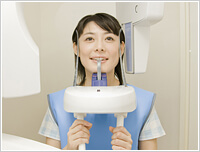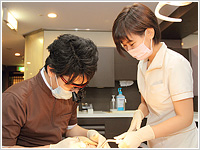Wisdom teeth extraction
Should I get my wisdom teeth removed?

Why you should get your wisdom teeth removed
The eighth tooth counting from the front center is the wisdom tooth (also called the third molar or intellect tooth). If
your wisdom tooth has grown in the correct position and you can chew normally, there is no need to force it to be removed.
However, since wisdom teeth grow at the very back, they are difficult to brush and prone to cavities and periodontal disease. If you do not take adequate care of them, you can also damage the important "molar" in front of the wisdom tooth.
If your wisdom tooth develops a cavity, it is difficult to reach with treatment tools and maintenance is difficult, so even if you treat it, there is a high chance of it recurring. For this reason, there are many cases where the tooth is extracted without treatment.
Nowadays, many people have small faces and jaws, so there is no space for wisdom teeth to grow, and few people have them grow in properly. Wisdom teeth that grow sideways or diagonally can cause inflammation of the gums as they grow in, resulting in pain and swelling.
In addition, the force of the teeth growing in can push other teeth forward, causing misalignment.
These are the reasons why it is generally said that it is better to have wisdom teeth removed.
Beware of these symptoms
Swollen gums around wisdom teeth
If a wisdom tooth is partially protruding from the gums or is growing in the wrong direction, bacteria can enter through the gap between the tooth and the gums, causing inflammation and leading to swollen and suppurating gums.
Wisdom teeth hurt or have holes
Food debris and dirt tend to accumulate in the gap between the wisdom tooth and the gums, which can lead to cavities along with the adjacent molar in front.
Wisdom teeth hurt when chewing
Depending on the orientation and position of your wisdom teeth, they may rub against your gums when you bite down, causing pain.
Teeth alignment
Depending on the direction and position of the wisdom tooth, it may put pressure on the teeth in front, causing misalignment of the teeth.
Flow of wisdom teeth treatment
- Check the status of your wisdom teeth

We will interview you, examine you, and take X-rays to confirm the state of your wisdom teeth and the condition of their roots. We will then explain the X-rays to you. At this time, we will decide whether or not it is best to have the tooth extracted, and whether or not it is possible to do so at our clinic.
- The day of tooth extraction

The tooth will be extracted after confirming that the swelling in the gums and the pain have subsided. After administering anesthesia, the tooth will be extracted and medication will be prescribed.
The procedure takes about 30 minutes for a normal tooth extraction, and about an hour for impacted wisdom teeth. - Disinfection after tooth extraction
The day after the tooth extraction, the area will be disinfected.
- Removal of stitches
The sutures will be removed about a week after the tooth is extracted.
Frequently asked questions about wisdom teeth
Q: How long will I be swollen after having a tooth extracted?
In the case of simple upper wisdom tooth extraction, painkillers are usually only needed for about a day, but some people experience pain for a week.
Swelling also depends greatly on the position of the wisdom tooth and the patient's constitution.
Q. Can both the upper and lower wisdom teeth be removed at the same time?
When lower wisdom teeth are removed, swelling often occurs, so if both left and right teeth are removed at the same time, it may be difficult to eat and may put a lot of strain on the body.
If you want to reduce the number of extractions, you can have the upper and lower teeth extracted the first time and the opposite side the second time, but this depends on the condition of each tooth and your physical condition, so it is not always possible.
Please consult with your doctor first.
Q: How do you extract impacted wisdom teeth?
It depends on the state of the tooth, but basically, the gums are cut a little (about 5 to 10 mm) to make the tooth easier to see and then the tooth is extracted.
If the tooth is tilted to the side, the tooth is filed down and divided into small pieces before being extracted. Finally, the tooth is firmly sewn up with thread to help the wound heal.

